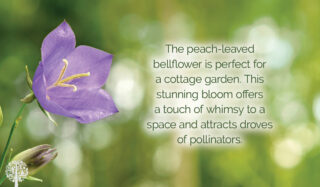It was love at first sight when I saw the peach-leaved bellflower. A cottage garden favorite, peach-leaved bellflowers tick all the boxes. They are hardy, reasonably disease-resistant, and can be grown in soft pastel shades of mauve, white, or pink. They are almost half a meter in height and are perfect for the back of a perennial bed. Producing large outward-faced bell-shaped flowers that cascade up the stalk, they bloom late spring right through to July.
Part of the campanula family, which includes trailing varieties and those that trundle along the ground, my adoration of campanula persicifolia warrants the honour of plant of the month.
Bellflowers Are Easy to Care For!
Hardy to zone 3 or -35°C, peach-leaved bellflowers are one of the easiest plants to care for. They prefer full to partial sunlight in moist, well-draining soil. You only need to water them when the soil surface appears dry. As the flowers fade, remove them from the stem; within days, another bud will form, and new flowers will appear. They will keep blooming until the real heat of summer.
They will require some support through wind and rain. I use stakes to hold each stem, but encompassing the clump with a tomato cage works, too.
Pests and Diseases
Peach-leaved bellflowers can be prone to powdery mildew and slugs, but I haven’t encountered these issues.
How do You Propagate Peach-Leaved Bellflowers?
Unlike other plants with long fibrous tap roots, peach-leaved bellflowers enjoy feeling cramped into a container.
Divide the plants every three to five years and create new colonies to spread the wealth throughout the garden. Peach-leaved bellflowers are also self-seeding. If the flower head is left to dry out naturally, capsules will develop that produce and release seeds.
Cuttings can also propagate peach-leaved bellflowers. Removing the bottom leaves about two inches up the stem. Bury the cut end in two inches of well-draining potting mix, keep it moist and warm until roots form, and then transplant it back into the garden.


With a Little Love, Flowers Will Thrive for a Longtime
Once established, a peach-leaved bellflower will live for decades, self-seeding and spreading throughout the garden. What’s not to like about that? My two clumps have survived cold winters, hot summers and drought; after almost ten years, they still look beautiful. They are a haven for butterflies and bees, and the resident hummingbirds get very possessive if another hummingbird dares to interrupt their meal.
Foxgloves, delphinium, cranesbill, salvia, and Lamb’s Ear are great companion plants for this whimsical cottage garden favorite. With synonyms that include Fairy Bells and Fairy Bellflower, they might even entice a garden gnome or nature fairy to come by for a visit!
![]()